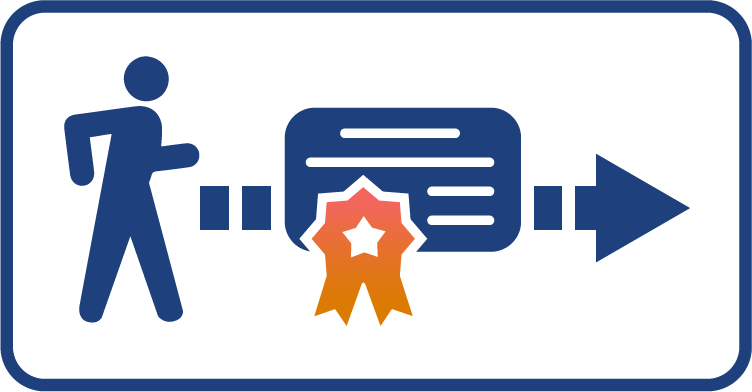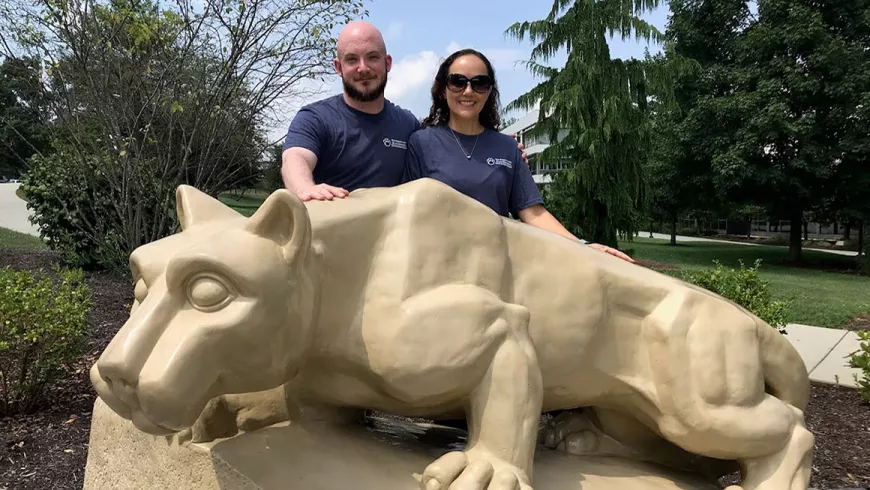Hands-On Experience
Complete a valuable internship alongside your online course work.
Application deadline
Credits and costs
Gain Skills to Manage and Protect Information Systems with an IT Degree
Understand security risk factors and the impact they can have on information systems at the organizational and global levels.
Design, develop, and implement secure information systems using the latest industry standards and best practices.
Manage various information systems, including database, web, and multimedia systems.
Leverage contemporary technology for the creation, organization, storage, analysis, communication, and transmission of information.
Develop hands-on knowledge through team projects, a required internship, and a capstone experience focusing on issues and technologies in the field.
Customize Your Online Information Technology Degree Courses
Customize Your Online Information Technology Degree Courses
This 60-credit associate degree program can help you develop your writing, business, and management skills, all within a contemporary context of the information sciences. You can also choose from five options to tailor your degree to meet your interests and goals.
Application Development Option — helps students prepare for an entry-level position in applications and/or web development. It also can be a stepping-stone for IST–related bachelor’s degrees. Course work will cover web development and advanced java programming as well as usability.
Custom Option — allows students to work closely with an adviser to develop a flexible academic program that provides a breadth of technical specialization. Students may select courses that support their current career path or add one of our undergraduate certificates to complete this option.
Cybersecurity Option — can prepare students for an entry-level position in the cybersecurity field. It also can position them for IST–related bachelor’s programs like cybersecurity analytics and operations or security and risk analysis. This option features introductory courses in cybersecurity and security and risk analysis as well as advanced hand-on courses in these fields of study.
Generalized Business Option — features courses in accounting, marketing, and management to help students build a framework of business concepts and practices that they can incorporate into their IT experience, add to their résumé, and use to improve marketability across industries.
Networking Option — provides an innovative curriculum that identifies and explains new and ever-evolving technologies in the IT field. This option balances theoretical knowledge with real-world experiences and is designed to bridge the gap between business and information technology professionals.
The networking option can help prepare students who plan to pursue professional IT certification examinations, including Computing Technology Industry Association (CompTIA) A+, Network+, and Server+ exams, as well as exams to be certified as a Microsoft Certified Solutions Associate (MCSA) and Cisco Certified Network Associate (CCNA).
Prescribed Courses (select 21 credits)
- 3credits
The use, analysis, and design of information systems and technologies to organize, coordinate, and inform human enterprises.
- Note
The credits earned in this course may be applied toward the Social and Behavioral Sciences (GS) requirement.
- or:3credits
This is an introductory university-level course in computer systems literacy. The history, architecture and operation of computing systems and underlying computing theory are covered.
- Option requirement
Students planning to complete the Cybersecurity option must select CYBER 100/100S
- or:3credits
Examines the relationship between physical capabilities, cognitive and social models, and philosophical issues pertinent to human-centered analysis, design and development work.
- or:3credits
This introductory course spans areas of security, risk, and analysis covering contexts in government agencies and business organizations.
- 3credits
A first course in concepts and skills for application development.
- Prerequisite
C or better in MATH 21 or placement above the level of MATH 21 in the mathematics placement test.
- Recommend preparation
MATH 22
- C or better
A student enrolled in this course must receive a grade of C or better.
- 3credits
Introduction to the concept of databases, including the storage, manipulation, evaluation, and display of data, and related issues.
- 3credits
Introduction to digital network topologies, transmission media, signal modulation, digital packet switching and routing, systems integration, communications management, and security.
- 3credits
Introduction to how the World Wide Web utilizes emerging technologies. Students acquire a conceptual understanding of constructing websites.
- or:3credits
This course will provide students with the knowledge and skills to create both basic and more dynamic web-based content pages and applications.
- Prerequisite
IST 250 or IST 242 or CMPSC 122 or CMPSC 132
- Note
IST 256 may count in the major requirements or the option, but cannot double count toward both requirements
- 3credits
Introduction to systems analysis and design, stressing the process of requirements acquisition, specification, design, and implementation.
- Prerequisite
IST 110, IST 210, IST 220, and ENGL 15
- C or better
A student enrolled in this course must receive a grade of C or better.
- 1credit
Supervised experience in which student teams work on information system design projects gathered from industry or units within the University.
- Prerequisite
IST 110
- C or better
A student enrolled in this course must receive a grade of C or better.
- Note
IST students may be able to receive full academic credit by submitting a portfolio of technical work samples created from their full-time work experiences that are no more than two years old.
- or:1credit
Supervised work experience in which the student is employed in an information sciences and technology position in industry, government, or academia.
- Prerequisite
IST 110
- C or better
A student enrolled in this course must receive a grade of C or better.
- Note
IST students may be able to receive full academic credit by submitting a portfolio of technical work samples created from their full-time work experiences that are no more than two years old.
Prescribed General Education Courses (select 12 credits)
- 3credits
Introduction to speech communication: formal speaking, group discussion, analysis and evaluation of messages.
- 3credits
Quadratic equations; equations in quadratic form; word problems; graphing; algebraic fractions; negative and rational exponents; radicals.
- GQ
This course can be used to satisfy the Quantification (GQ) requirement.
- or:3credits
Relations, functions, graphs; polynomial, rational functions, graphs; word problems; nonlinear inequalities; inverse functions; exponential, logarithmic functions; conic sections; simultaneous equations.
- GQ
This course can be used to satisfy the Quantification (GQ) requirement.
- or:3credits
Trigonometric functions; solutions of triangles; trigonometric equations; identities.
- Prerequisite
MATH 021 or satisfactory performance on the mathematics placement examination.
- GQ
This course can be used to satisfy the Quantification (GQ) requirement.
- or:4credits
Introduces and develops the mathematical skills required for analyzing change, and the underlying mathematical behaviors that model real-life economics and financial applications. Develops student knowledge of calculus techniques, and how to use a calculus framework to develop critical thinking and problem-solving skills.
- Prerequisite
MATH 022 or satisfactory performance on the mathematics placement examination
- or:4credits
Introduces and develops the mathematical skills required for analyzing change and creating mathematical models that replicate real-life phenomena. Develops student knowledge of calculus techniques and how to use the calculus environment to develop critical thinking and problem-solving skills.
- Prerequisite
MATH 22 and MATH 26 or MATH 26 and satisfactory performance on the mathematics placement examination or MATH 40 or MATH 41 or satisfactory performance on the mathematics placement examination.
- or:4credits
Descriptive Statistics, frequency distributions, probability and normal distributions, statistical inference, linear regression, and correlation.
- Prerequisite
Placement into MATH 21 or higher.
- 3credits
An intensive, rhetorically based experience in reading and writing that will prepare you both to understand the communications that surround you and to succeed in your own communication efforts.
- Prerequisite
ENGL 4 or satisfactory performance on the English placement examination
- GWS
The credits earned in this course may be applied toward the Writing/Speaking (GWS) requirement.
- 3credits
Writing for students in scientific and technical disciplines.
- Prerequisite
ENGL 15, ESL 15, ENGL 30, and 4th Semester standing OR ENGL 137H, ENGL 138T, and 4th Semester standing
- GWS
This course can be used to satisfy the Writing/Speaking (GWS) requirement.
- or:3credits
Writing reports and other common forms of business communication.
- Prerequisite
(ENGL 15 or ENGL 30) and fourth-semester standing
- GWS
The credits earned in this course may be applied toward the Writing/Speaking (GWS) requirement.
Option Requirements
Courses vary based on the option selected. Review the following lists for each option's unique requirements.
- 3credits
Intermediate application development including algorithms, data structures, and object-oriented concepts.
- Prerequisite
A grade of C or better in IST 140 or CMPSC 121 or IST 240
- 3credits
This course will provide students with the knowledge and skills to create both basic and more dynamic web-based content pages and applications.
- Prerequisite
IST 250 or IST 242 or CMPSC 122 or CMPSC 132
- Note
IST 256 may count in the major requirements or the option, but cannot double count toward both requirements
- 3credits
Introductory design and development studio course for IST and SRA students.
- Prerequisite
A grade of C or better in IST 242 or permission of program
- 3credits
Introduction to object-oriented applications, including applications in an Object-Oriented Design (OOD) language or OOD languages.
- Prerequisite
A grade of C or better in IST 242 or CMPSC 221
- 3credits
Interdisciplinary survey of topics and methods related to the human-centered design use and usability of information systems.
- Prerequisite
A grade of C or better in IST 240 or IST 242
- 3credits
Provides an understanding of the overview of information security including security architecture, access control, and internet secure applications.
- Prerequisite
SRA 111 and (CMPSC 101 or IST 140 or CMPSC 121)
- 3credits
This studio course teaches four basic hands-on cyber-defense skills: configuring a firewall, implementing a host-based intrusion detection software tool, using the Metasploit tool to do penetration testing, and implementing a network intrusion detection tool.
- Prerequisite
(CYBER 100 or CYBER 100S) and IST 140
- 3credits
Intermediate application development including algorithms, data structures, and object-oriented concepts.
- Prerequisite
A grade of C or better in IST 140 or CMPSC 121 or IST 240
- 3credits
This introductory course spans areas of security, risk, and analysis covering contexts in government agencies and business organizations.
- 3credits
Provides overview of nature, scope, and seriousness of threats to security as a result of terrorism and crime.
- 4credits
Introduction to the role of accounting numbers in the process of managing a business and in investor decision-making.
- Prerequisite
MATH 21 or 1.5 units of high school algebra
- 4credits
Explores the ethical, political, social, legal and regulatory, technological, and demographic diversity environment of business.
- Note
A student may not receive credit toward graduation for both BLAW 243 and BA 243.
- 3credits
Methods of economic analysis and their use; price determination; theory of the firm; distribution.
- or:3credits
National income measurement; aggregate economic models; money and income; policy problems.
- 3credits
Nature of finance function; risk and return concepts; working capital; dividend policies; mergers; security markets; acquisition and management of corporate capital; analysis of operations; forecasting capital requirements; raising capital; and planning profits. Available to baccalaureate students only.
- Prerequisite
(ENGL 15 or ENGL 30) and ACCTG 211 and (ECON 102 or ECON 104) and (SCM 200 or STAT 200)
- 3credits
Study of fundamental principles and processes available to the understanding of management.
- Prerequisite
(ENGL 15 or ENGL 30) and (ECON 102 or ECON 104) and (MATH 021 or higher or satisfactory score on the mathematics placement examination)
- 3credits
Covers terminology and important concepts related to marketing in the business environment. Domestic and international environments that impact marketing are included, with particular emphasis on the marketing environment, segmentation, positioning, and targeting. Not available to students who have taken BA 303.
- Prerequisite
(ENGL 15 or ENGL 30) and (ECON 102 or ECON 104) and (MATH 021 or higher or satisfactory score on the mathematics placement examination.)
- 3credits
Supply chain management concepts, principles, and methodologies.
- Prerequisite
ACCTG 211 and ECON 102 and (SCM 200 or STAT 200)
- 3credits
Preparation for PC hardware support: Students learn data recovery and how to build, configure, upgrade, troubleshoot, diagnose, and repair PCs.
- Prerequisite
IST 220
- 3credits
Concepts for peer-to-peer and server-based network: International Organization for Standardization-Open Systems Interconnection (ISO-OSI) reference model, industry standards, troubleshooting, performance monitoring, and optimization.
- Prerequisite
IST 220
- 3credits
Administering peer-to-peer and client/server networks: Planning, installation, server configuration, resource management, remote access, performance monitoring, and optimization.
- Prerequisite
IST 226
- 3credits
TCP/IP planning, installation, configuration: IP addressing, subnetting, routing, Dynamic Host Configuration Protocol (DHCP), Windows Internet Naming Service (WINS), address/name resolution, Domain Name System (DNS); database, web, mail server management.
- Prerequisite
IST 226
Electives (select 5–9 credits)
Courses chosen in consultation with an adviser.
General Education Requirements
Some General Education requirements may be satisfied by courses required for the major. Students should work with an adviser to select courses.
- Arts (GA): 3 credits
- Humanities (GH): 3 credits
- Natural Sciences (GN): 3 credits
- Social and Behavioral Sciences (GS): 3 credits
- Writing and Speaking (GWS): 3 credits
- Quantification (GQ): 3 credits
- Any General Education course, including Integrative Studies (Inter-domain or Linked courses): 3 credits
- United States Cultures (US), or International Cultures (IL) or combined designation (US; IL): 3 credits
May be satisfied by designated courses that also meet other degree or General Education requirements. - Writing Across the Curriculum (W, M, X, Y): 3 credits
May be satisfied by designated courses that also meet other degree or General Education requirements.
Course Availability
If you're ready to see when your courses will be offered, visit our public LionPATH course search (opens in new window) to start planning ahead.
Start or Advance Your Career

Start or Advance Your Career
Nearly all types of organizations — from retail establishments and manufacturing plants to service industries and health care facilities — need employees who understand information technology (IT). And as IT operations continue to expand, so do the number of entry-level jobs and the demand for additional IT workers.
This associate degree is structured to prepare graduates for immediate and continuing career opportunities in the broad discipline of information sciences and technology.
Job Titles Related to This Degree
The following roles are often held by people with this type of degree:
- Business Records Manager
- Computer Network Specialist
- Information Technology Specialist (IT Specialist)
- Web Administrator
- Web Technologies Administrator
Employment Outlook for Occupational Fields Related to This Degree
Estimates of employment growth and total employment are provided by the U.S. Bureau of Labor Statistics and are subject to change. While these occupations are often pursued by graduates with this degree, individual outcomes may vary depending on a variety of factors. Penn State World Campus cannot guarantee employment in a given occupation.
Computer Network Support Specialists
Network and Computer Systems Administrators
Career Services to Set You Up for Success

From the day you're accepted as a student, you can access resources and tools provided by Penn State World Campus Career Services to further your career. These resources are beneficial whether you're searching for a job or advancing in an established career.
- Opportunities to connect with employers
- Career counselor/coach support
- Occupation and salary information
- Internships
- Graduate school resources
Ready to Learn More?
Get the resources you need to make informed decisions about your education. Request information on this program and other programs of interest by completing this form.
Ready to take the next step toward your Penn State associate degree?
Costs and Financial Aid
Costs and Financial Aid
Learn about this program's tuition, fees, scholarship opportunities, grants, payment options, and military benefits.
Costs and Financial Aid
Undergraduate Tuition
Undergraduate tuition is calculated based on the number of credits for which you register and the number of total credits you have accrued at or transferred to Penn State.
Tuition is due shortly after each semester begins and rates are assessed every semester of enrollment.
2024–25 Academic Year Rates
| How many credits do you plan to take per semester? | If you have 59 or fewer credits | If you have 60 or more credits |
|---|---|---|
| 11 or fewer | $632 per credit | $678 per credit |
| 12–19 | $7,678 per semester | $8,288 per semester |
2025–26 Academic Year Rates
| How many credits do you plan to take per semester? | If you have 59 or fewer credits | If you have 60 or more credits |
|---|---|---|
| 11 or fewer | $638 per credit | $685 per credit |
| 12–19 | $7,755 per semester | $8,371 per semester |
Undergraduate students taking more than 19 credits will be charged the flat tuition rate plus the regular per credit hour rate for each credit above 19.
Financial Aid and Military Benefits
Some students may qualify for financial aid. Take the time to research financial aid, scholarships, and payment options as you prepare to apply. Federal financial aid may only be used to pay for credits used to satisfy program requirements.
Military service members, veterans, and their spouses or dependents should explore these potential military education benefits and financial aid opportunities, as well.
Additional Cost of Attendance Details
To view the detailed list of cost of attendance elements:
- visit the Tuition Information site
- click the plus sign to expand the table
- select a semester from the World Campus row
Who Should Apply?
This IT associate degree program is designed for working professionals with little or no formal background in information technology and for people who want to pursue a career in technology management.
Head Start toward a Bachelor's Degree

Head Start toward a Bachelor's Degree
Not only can this program help create opportunities in your career, it can also give you a solid head start toward a full bachelor’s degree.
Bachelor's Degree Program Related to This Associate Degree
If you choose to continue your studies, some of the credits you earn toward your associate degree may be applied toward the requirements for the following bachelor's degree at Penn State:
This online bachelor’s IT degree program explores how we can strengthen the power of information and technology and use it to increase human potential. The course work focuses on creating innovative systems and technology solutions in a wide range of industries.
Learn more about the Bachelor of Science in Information Sciences and TechnologySet Your Own Pace

Set Your Own Pace
Whether you are looking to finish your program as quickly as possible or balance your studies with your busy life, Penn State World Campus can help you achieve your education goals. Many students take one or two courses per semester.
Our online courses typically follow a 12- to 15-week semester cycle, and there are three semesters per year (spring, summer, and fall). If you plan to take a heavy course load, you should expect your course work to be your primary focus and discuss your schedule with your academic adviser.
To Finish Your Degree in One to Two Years
- Take 4–5 courses each semester
To Finish Your Degree in Three or More Years
- Take 2–3 course each semester
Timelines may vary for students transferring credits from another school or based on course availability.
Convenient Online Format
This program's convenient online format gives you the flexibility you need to study around your busy schedule. You can skip the lengthy commute without sacrificing the quality of your education and prepare yourself for more rewarding career opportunities without leaving your home.
A Trusted Leader in Online Education

Penn State has a history of more than 100 years of distance education, and World Campus has been a leader in online learning for more than two decades. Our online learning environment offers the same quality education that our students experience on campus.
How to Apply to Penn State

How to Apply to Penn State
Apply by June 30 to start August 25
Application Instructions
Deadlines and Important Dates
Complete your application and submit all required materials by the appropriate deadline. Your deadline will depend on the semester you plan to start your courses.
Fall Deadline
Apply by June 30 to start August 25Spring Deadline
Apply by October 31 to start January 12Summer Deadline
Apply by March 15, 2026, to start May 18, 2026
Steps to Apply
To apply for this program, you must be a high school graduate, or have completed your GED.
You will need the following items to complete your application:
High school transcripts or GED transcript — First-year applicants are required to submit Self-Reported Academic Records (SRAR) when applying. Official high school transcripts for first-year applicants will only be required at the time a student accepts an offer of admission to Penn State.
Transfer international students will need to submit their high school transcript before their application can be reviewed.
Official college or university transcripts and/or official military transcripts (if applicable) — All college or university transcripts are required regardless of the length of time that has passed, the grades earned, or the accreditation of the institutions attended. Acceptance of transfer credit toward your degree is subject to final approval by the academic department. For detailed information, see the Transfer Students page.
Transcripts not in English must be accompanied by a certified translation.
English Proficiency — The language of instruction at Penn State is English. With some exceptions, international applicants must take and submit scores for the Test of English as a Foreign Language (TOEFL) or International English Language Testing System (IELTS). Minimum test scores and exceptions are found in the English Language Proficiency section on the Undergraduate Admissions International Requirements page. Visit the TOEFL website for testing information. Penn State's institutional code is 2660.
To begin the online application, you will need a Penn State account.
Create a New Penn State Account
If you have any problems during this process, contact an admissions counselor at [email protected].
Please note: Former Penn State students may not need to complete the admissions application or create a new Penn State account. Please visit our Returning Students page for instructions.
Accessing MyPennState
The MyPennState Portal provides access to our online admissions services. Before accessing MyPennState, you must have a Penn State account that will be used to access all Penn State systems. After creating an account, you will receive a unique Penn State User ID. You will need to enter your User ID followed by @psu.edu when signing in to MyPennState and other Penn State sites. For example, you should be entering something like '[email protected]' in the Sign In field.
The application consists of six sections:
- Application Setup
- Program of Study
- Citizenship and Residency
- Academics and Experience
- Miscellaneous
- Review and Submit
Application Setup
Be sure to select "Online" for the "How would you like to complete your degree" question if you plan to attend Penn State World Campus.
The rest of this section will ask some basic questions about your education experience and military affiliation.
Program of Study
You will choose the degree type and then the starting semester.
Your starting campus will be selected as Penn State World Campus by default as long as you picked "Online" in your Application Setup. Click Continue.
On the Choose a Program page, select your intended major from the list.
Review your selection on the summary screen and click Continue to move on to the Citizenship and Residency section.
Citizenship and Residency
Complete the series of questions about your citizenship status, demographic information, Pennsylvania residency status, and family history.
Academics and Experience
You will need to enter academic experience information about your high school and any attempted courses at a college or university after high school.
The Education Gap Statement offers a place to explain any time that has elapsed between your high school graduation and your anticipated enrollment at Penn State. Please provide a summary of why that gap occurred. Some examples that would explain a gap in your education include work, family, attending another college or university, etc.
Miscellaneous
In the Miscellaneous section, you will provide any program-specific requirements (e.g., a personal statement), information about activities, and financial aid information.
Review and Submit
Review your information, digitally sign your application, and provide payment for the application fee ($65 domestic or $75 international).
High School Transcripts and Academic Record
After your application is completed, you will also need to self-report your high school course work before the application deadline. You will be directed to fill out the Self-Reported Academic Record (SRAR). It is helpful to have a high school transcript available when completing this section. In the third section, you'll select your program of study and campus.
Official high school transcripts or GED transcript, along with records from high school, are required, regardless of the length of time that has passed.
Include any college/university transcripts (required), military transcripts, and Proof of English Language proficiency (if applicable). SAT/ACT scores are not required if you are identified as an adult learner or transfer student.
All official documents should be sent to:
Undergraduate Admissions Office
The Pennsylvania State University
201 Shields Building
University Park, PA 16802You can also have your transcripts sent electronically through Parchment, eScript-Safe, or the National Clearinghouse directly to Penn State from the college/university where course work was attempted.
Acceptance
After receiving your application, application fee, and all required materials, your application will be evaluated for admission. You can check your application status online. This will provide the most up‐to‐date information about the status of your application and is updated once daily, before 8:00 a.m. (ET). Once a decision has been made regarding your application, it will be available to you through the MyPennState portal.
For information on when you can expect an admissions decision, visit the Dates and Deadlines page of the Undergraduate Admissions website. Make sure you click the "+" sign to see these dates for World Campus Applicants (First-Year and Transfer).
5. Complete the application.
Admissions Help
If you have questions about the admissions process, contact an admissions counselor at [email protected].
Contact Us

Contact Us
Have questions or want more information? We're happy to talk.
To learn more about the Associate in Science in Information Sciences and Technology, please contact:
World Campus Admissions Counselors
Phone: 814-863-5386
Email: [email protected]
Learn from the Best
Learn from the Best
The Associate in Science in Information Sciences and Technology is offered in partnership with the Penn State College of Information Sciences and Technology, which is a leader among an emerging group in higher education known as i-schools, or information schools.
Our faculty members are a diverse group of thought leaders from numerous fields, including computer science, engineering, psychology, chemistry, and artificial intelligence.
Faculty
James (Jim) Farrugia
- DegreePh.D., Spatial Information Science and Engineering, University of Maine
- DegreeM.S., Library Science, University of North Carolina at Chapel Hill
- DegreeB.A., Mathematics, East Stroudsburg University
Dr. James (Jim) Farrugia is an assistant teaching professor of information sciences and technology. His areas of interest include programming, software development, data synthesis, and design and development.
Chris Gamrat
- DegreePh.D., Learning, Design, and Technology, Penn State
- DegreeM.Ed., Instructional Systems, Penn State
- DegreeB.S., Management Information Systems, Penn State
Dr. Chris Gamrat served as an instructional designer for the College of IST since 2013 and became a faculty member in 2022. Prior to joining IST, Dr. Gamrat served as a technology specialist for the NASA Aerospace Education Services Project at the Penn State College of Education, starting in 2008. His research interests include inclusive teaching, innovations in teaching and learning, and microcredentials.
Richard Lomotey
- DegreePh.D., Computer Science, University of Saskatchewan
- DegreeMSc., Computer Science, University of Saskatchewan
- DegreeB.Sc., Computer Science, University of Cape Coast
Dr. Richard Lomotey is a tenured associate professor of information sciences and technology at Penn State. He teaches a variety of courses at the undergraduate and graduate levels, and his research focuses on emerging technologies (such as mobile computing, IoT, and machine learning) in diverse domains, including health, agriculture, gamification, and enterprises.
Gregory O'Toole
DegreePh.D., Media and Communication, European Graduate School, Saas-Fee, SwitzerlandDr. Gregory O'Toole is a lecturer in information sciences and technology at Penn State Abington. His areas of interest are open source web design and development, web research, and education.
Kaamran Raahemifar
- DegreePh.D., University of Windsor
- DegreeMASc, University of Waterloo
Dr. Kaamran Raahemifar is a professor in the artificial intelligence and data science programs in the Penn State College of Information Sciences and Technology. He has several decades of combined experience in teaching, research, and administrative/executive services. He has research and teaching interests in applied optimization, data modeling and prediction, small and large system simulation and design, signal anomaly detection and testing, blockchain, data science, artificial intelligence, user experience, and smart-connected devices.
Jeffrey Rimland
- DegreePh.D., Information Sciences, Penn State
- DegreeB.S., Computer Science, Penn State
Dr. Jeffrey Rimland is an assistant teaching professor of information sciences and technology. His areas of interest are software development, vocal synthesis techniques, information fusion, assistive mobile device technology, and human-centric information.
Syed Rizvi
- DegreePh.D., Computer Science and Engineering, University of Bridgeport
- DegreeM.S., Computer Engineering, Old Dominion University
- DegreeB.S., Computer Engineering, Sir Syed University of Engineering and Technology
Dr. Syed Rizvi is an associate professor in information sciences and technology at the Penn State Altoona campus. His research interests lie at the intersection of computer networking, network security, and machine learning. Dr. Rizvi teaches cybersecurity, risk analysis, and IST courses such as fundamentals of information security, networking and telecommunications, secure software engineering, security risk assessment, network security, incident response handling, and capstone projects. He is a member of the IEEE Communications Society and ACM.
News



